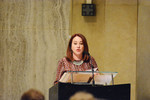

Archbishop Luis Castro Quiroga of Tunja, Colombia, illustrated a point about the ethical, spiritual and cultural foundations of peace building through a story he delivered at the Prayer Service on the Vigil of the Opening of the 73rd Session of the United Nations General Assembly Sept. 17 at Holy Family Church in Manhattan.
“A man went out hunting in the forest. Suddenly, he saw a gigantic shadow and got ready to shoot. He looked more carefully and saw that it was the shadow of a human being. He thought, ‘It must be an enemy’ and prepared to shoot. He looked again and realized that it was the shadow of his brother, who had also gone out to hunt. They embraced each other.”
Archbishop Quiroga concluded that the change of perception “from animal to human and from human to brother is what we need in Colombia and throughout the world so that all of us can become a true United Nations,” united in peace and in fraternity.”
The former president of the Colombian Conference of Bishops, Archbishop Quiroga helped lead the fight for the peace accord in Colombia. The peace process in Colombia, he explained, concluded with an agreement between the Colombian government and the Revolutionary Armed Forces of Colombia, FARC.
Apostolic Nuncio Archbishop Bernardito Auza, permanent observer of the Holy See to the United Nations, presided at the liturgy. Also in attendance were António Guterres, Secretary-General of the United Nations, and María Fernanda Espinosa Garcés, president of the 73rd Session of the General Assembly.
Also invited by Archbishop Auza to pray for peace and blessings upon the upcoming meetings were other diplomats, dignitaries, U.N. staff and representatives of various countries, along with parishioners.
Members of the Christian clergy, and clergy and representatives of other religious faiths, were also present.
Known as the United Nations parish, Holy Family, on East 47th Street, is located around the corner from U.N. headquarters. Father Gerald Murray, pastor of Holy Family, welcomed the congregants and offered the invocation.
After 52 years of armed conflict in Colombia, government and rebel leaders reached a peace accord in late 2016 that put an official end to a war that claimed more than 200,000 lives and displaced almost 7 million people. Pope Francis’ visit to Colombia in September 2017 underscored the Church’s commitment to peace and its focus on the victims of the conflict.
Archbishop Quiroga also shared in his meditation at the prayer service 10 elements of peace that have guided the peace process: peace is a gift from God; peace calls for dialogue; peace demands dedication; peace is a defense of life; peace has a duel aspect, an inner peace and an exterior peace; peace brings joy; reconciliation with God and others; truth is a path to reconciliation; justice with mercy; and peace building.
The United Nations, Archbishop Quiroga said, works with two concepts of peace: peacemaking and peace building. Peacemaking, he said, implies putting an end to war by means of accords, whereas peace building suggests a new construction with a new and solid foundation. “Peace building has three elements: an ethical foundation of honesty, free from corruption; a spiritual foundation of forgiveness and reconciliation; and a cultural foundation to encourage a fraternity and a true ‘culture of life.’”
Guterres, in his remarks, said, that as a new session of the General Assembly was to begin, there were many mountains to climb, among them, nuclear peril and the growing scourge of inequality, but that there were also great opportunities to seize, and great achievements on which to build. “Our prayers tonight are well-timed,” he said, “let us translate them into deeds in the crucial period ahead.”
Ms. Espinosa Garcés, in her remarks, asked the assembly to consider “the plight of the millions of people who are on the move, and who have been on the move as migrants and as refugees. And today, as we prepare for the opening of the General Assembly, we must surely commit ourselves to finding long-lasting and humane solutions for the largest body of people to be on the move since the ending of the Second World War in the last century.”
The gathering also included a Prayer for Peace, a Prayer for Our Earth and a Prayer for Refugees and Migrants. The Prayers of Petition were delivered in Russian, French, Chinese, Arabic and Spanish.
Music, befitting the gathering, was provided by James D. Wetzel, director of music and organist at St. Vincent Ferrer and St. Catherine of Siena parish in Manhattan, and the Schola Cantorum of St. Vincent Ferrer.
Among the selections were the hymn, “O God of Every Nation” and, following the Prayer for Peace, the chorale response, sung in Latin, “Da Pacem, Domine, in Diebus Nostris (II).”
At a reception in the church’s undercroft after the liturgy, Rockville Centre Bishop John Barres told CNY that Archbishop Quiroga’s remarks resonated because, “for him to come to the United Nations and be part of this prayer service, and to share with beautiful Gospel simplicity the fundamentals of Gospel peace was a great inspiration and a message that everyone could receive with great enthusiasm.”
Bishop Gregory Mansour of the Maronite Eparchy of St. Maron of Brooklyn, said the evening was a reminder that “peace is not just our own effort, but also sometimes our own efforts don’t amount to much—we really need the gift of God, which is peace. We need to work as hard as we can for it, but we also have to get on our knees and pray for it.”